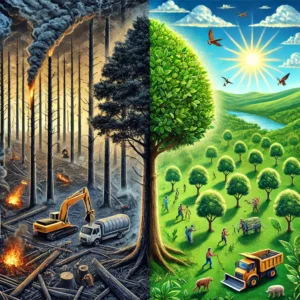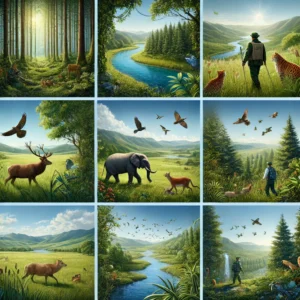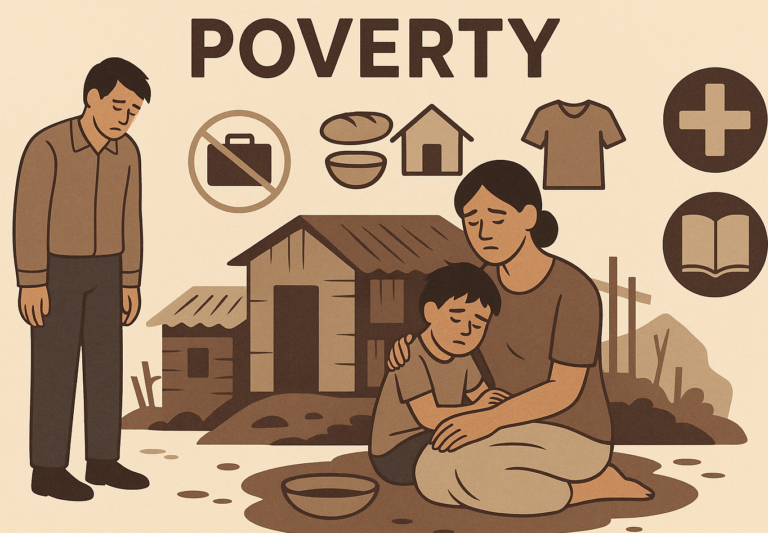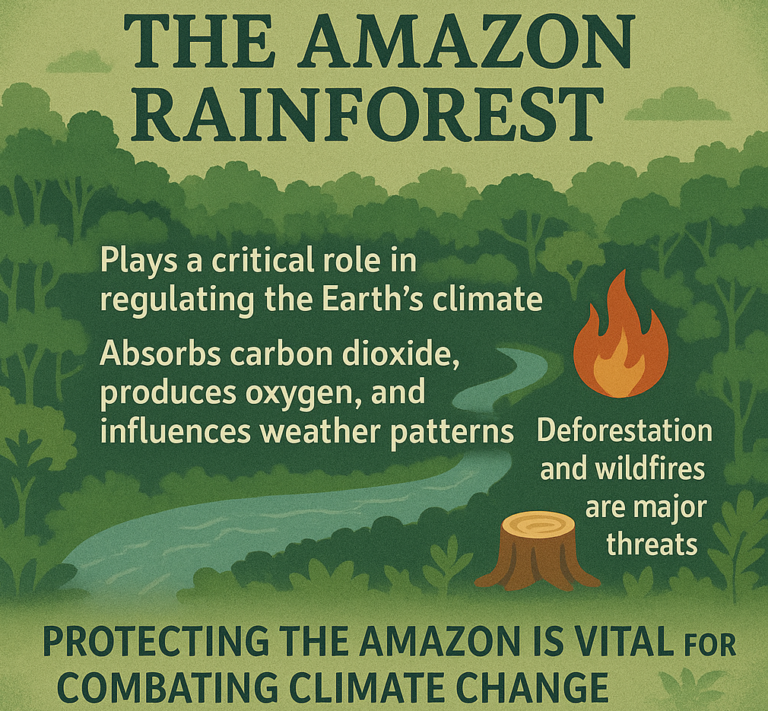An ecosystem is a community of living organisms (like plants, animals, and microorganisms) interacting with each other and their physical environment (like water, air, and soil). Ecosystems can vary in size and location, but they all share the same basic features of interaction and balance.

There are different types of ecosystems based on the climate, the organisms living in them, and the environment. Let’s look at the major types of ecosystems!
1. Terrestrial Ecosystems – Land-based Ecosystems
These ecosystems are found on land. They include forests, grasslands, deserts, and tundra, each with its own climate and types of plants and animals.
A. Forest Ecosystems
- What it is: Forest ecosystems are found in areas with lots of trees and plants.
- Key Features: They have a variety of plant and animal species, and the climate is usually moist.
- Examples:
- Tropical Rainforests (found near the equator, like the Amazon)
- Temperate Forests (found in moderate climates, like in parts of North America and Europe)
- Boreal Forests (also called taiga, found in cold regions like Canada and Russia)
B. Grassland Ecosystems
- What it is: Grasslands are large open areas covered with grasses and few trees.
- Key Features: They usually have seasonal rainfall, and many large herbivores like bison or zebras can be found here.
- Examples:
- Savannas (tropical grasslands, like in Africa)
- Prairies (temperate grasslands, like in the USA and Canada)
C. Desert Ecosystems
- What it is: Deserts are dry regions with very little rainfall, often characterized by sand dunes, cacti, and adapted animals.
- Key Features: They experience extreme temperatures, very hot during the day and cold at night.
- Examples:
- Sahara Desert (Africa)
- Sonoran Desert (USA and Mexico)
D. Tundra Ecosystems
- What it is: Tundras are cold, frozen regions with minimal plant life and short growing seasons.
- Key Features: The ground is often frozen (permafrost), and only small plants like mosses and lichens grow here. Animals like polar bears and caribou live in tundras.
- Examples:
- Arctic Tundra (around the North Pole)
- Alpine Tundra (high mountain areas)
2. Aquatic Ecosystems – Water-based Ecosystems
These ecosystems are found in water and can either be freshwater or saltwater.
A. Freshwater Ecosystems
- What it is: Freshwater ecosystems are found in areas with low salt content, like rivers, lakes, and ponds.
- Key Features: These ecosystems are home to fish, amphibians, and many types of plants.
- Examples:
- Lakes and Ponds (still water bodies)
- Rivers and Streams (flowing water bodies)
B. Marine (Saltwater) Ecosystems
- What it is: Marine ecosystems are found in oceans and seas, where the water has a high salt content.
- Key Features: These ecosystems support coral reefs, open oceans, and coastal areas. They are home to fish, whales, sharks, and sea turtles.
- Examples:
- Coral Reefs (found in tropical seas, like the Great Barrier Reef)
- Open Oceans (large bodies of saltwater)
- Estuaries (where freshwater meets seawater, like marshes)
3. Artificial Ecosystems – Human-made Ecosystems
These ecosystems are created and influenced by humans. They are designed for specific purposes and can be a part of cities or other areas where people live.
A. Urban Ecosystems
- What it is: These are ecosystems in cities or towns, where buildings, roads, and parks are mixed with nature.
- Key Features: They have plants, animals, and pollution, but also human-built structures.
- Examples:
- City Parks
- Green Spaces in Urban Areas
B. Agricultural Ecosystems
- What it is: Agricultural ecosystems are created by humans to grow crops and raise livestock.
- Key Features: They are controlled environments, with human influence on soil, water, and plant growth.
- Examples:
- Farms
- Fish Farms
4. Wetland Ecosystems – Waterlogged Land
Wetlands are areas where the soil is often submerged in water, either all year round or seasonally. They are vital for biodiversity and play an important role in water filtration.
- Key Features: Wetlands are home to unique plants and animals that are adapted to wet conditions.
- Examples:
- Swamps (with trees)
- Marshes (with grasses)
- Bogs (waterlogged with acidic soil)
Summary
Ecosystems can be grouped into terrestrial (land-based) and aquatic (water-based) types. Terrestrial ecosystems include forests, grasslands, deserts, and tundras, each with its own climate and living organisms. Aquatic ecosystems include freshwater environments like rivers and lakes, as well as marine environments like oceans and coral reefs. We also have artificial ecosystems created by humans, like urban areas and farms, and wetland ecosystems, which are unique areas where water and land meet.Each type of ecosystem is important for maintaining the balance of nature and supporting life on Earth











